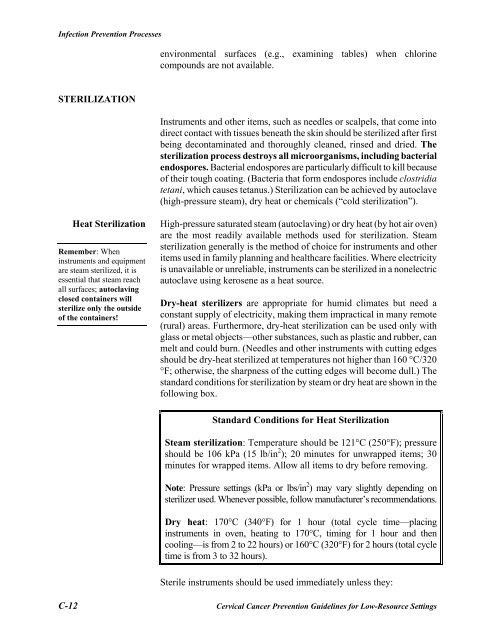Reference Manual - IARC Screening Group
Reference Manual - IARC Screening Group
Reference Manual - IARC Screening Group
Create successful ePaper yourself
Turn your PDF publications into a flip-book with our unique Google optimized e-Paper software.
Infection Prevention Processesenvironmental surfaces (e.g., examining tables) when chlorinecompounds are not available.STERILIZATIONInstruments and other items, such as needles or scalpels, that come intodirect contact with tissues beneath the skin should be sterilized after firstbeing decontaminated and thoroughly cleaned, rinsed and dried. Thesterilization process destroys all microorganisms, including bacterialendospores. Bacterial endospores are particularly difficult to kill becauseof their tough coating. (Bacteria that form endospores include clostridiatetani, which causes tetanus.) Sterilization can be achieved by autoclave(high-pressure steam), dry heat or chemicals (“cold sterilization”).Heat SterilizationRemember: Wheninstruments and equipmentare steam sterilized, it isessential that steam reachall surfaces; autoclavingclosed containers willsterilize only the outsideof the containers!High-pressure saturated steam (autoclaving) or dry heat (by hot air oven)are the most readily available methods used for sterilization. Steamsterilization generally is the method of choice for instruments and otheritems used in family planning and healthcare facilities. Where electricityis unavailable or unreliable, instruments can be sterilized in a nonelectricautoclave using kerosene as a heat source.Dry-heat sterilizers are appropriate for humid climates but need aconstant supply of electricity, making them impractical in many remote(rural) areas. Furthermore, dry-heat sterilization can be used only withglass or metal objects—other substances, such as plastic and rubber, canmelt and could burn. (Needles and other instruments with cutting edgesshould be dry-heat sterilized at temperatures not higher than 160 °C/320°F; otherwise, the sharpness of the cutting edges will become dull.) Thestandard conditions for sterilization by steam or dry heat are shown in thefollowing box.Standard Conditions for Heat SterilizationSteam sterilization: Temperature should be 121°C (250°F); pressureshould be 106 kPa (15 lb/in 2 ); 20 minutes for unwrapped items; 30minutes for wrapped items. Allow all items to dry before removing.Note: Pressure settings (kPa or lbs/in 2 ) may vary slightly depending onsterilizer used. Whenever possible, follow manufacturer’s recommendations.Dry heat: 170°C (340°F) for 1 hour (total cycle time—placinginstruments in oven, heating to 170°C, timing for 1 hour and thencooling—is from 2 to 22 hours) or 160°C (320°F) for 2 hours (total cycletime is from 3 to 32 hours).Sterile instruments should be used immediately unless they:C-12 Cervical Cancer Prevention Guidelines for Low-Resource Settings
















